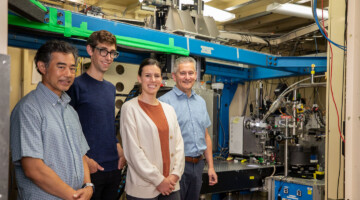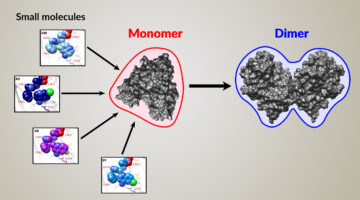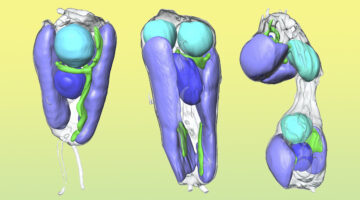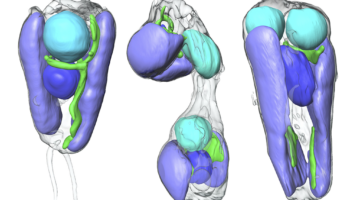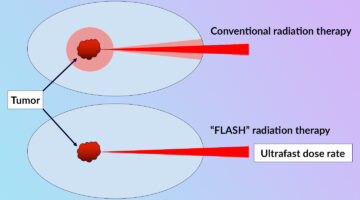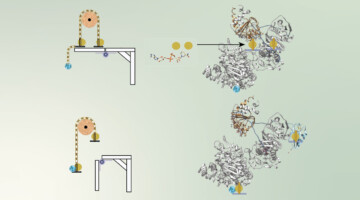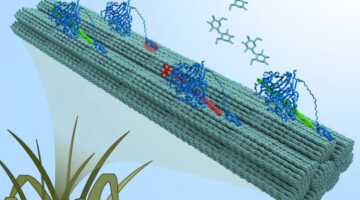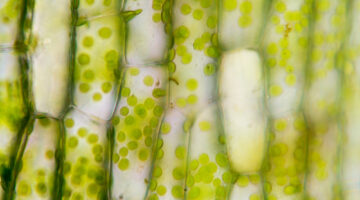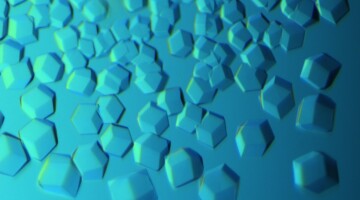In this work, researchers demonstrated a macromolecular scaffold that combines an 8-coordinate synthetic ligand and a mammalian protein to characterize the solution and solid-state behavior of the longest-lived actinium isotope. The information could help design better cancer treatments. Read more »
Time-Resolved SAXS Screen of Small-Molecule Drug Candidates
Time-resolved, high-throughput, small-angle x-ray scattering improved the screening of small-molecule drug candidates, providing insight into how they stimulate structural transitions in protein targets. The work will speed the discovery of treatments designed to activate biomolecular dynamics associated with desired therapeutic outcomes. Read more »![]()
![]()
Symbiotic Nitrogen-Fixing Microbe Evolves into Organelle
Researchers found that a symbiont capable of fixing nitrogen (turning it into a biologically usable form) has evolved into an organelle—an intrinsic part of the algae cells that host it. The discovery is of great interest for understanding organelle genesis and for efforts to engineer agricultural plants with built-in nitrogen-fixing capabilities. Read more »![]()
![]()
Scientists Discover First Nitrogen-Fixing Organelle
In two recent papers, an international team of scientists describe the first known nitrogen-fixing organelle within a eukaryotic cell. The organelle is the fourth example in history of primary endosymbiosis—the process by which a prokaryotic cell is engulfed by a eukaryotic cell and evolves beyond symbiosis into an organelle. Read more »
Nitrogen-fixing organelle in a marine alga
A nitrogen-fixing organelle, or “nitroplast,” has been identified in a marine alga on the basis of intracellular imaging and proteomic evidence. This discovery sheds light on the evolutionary transition from endosymbiont to organelle. The image depicts the cell architecture and synchronized cell division of the alga Braarudosphaera bigelowii with nitroplast UCYN-A (large brown spheres). Read more »
Clarifying the FLASH Effect for Cancer Radiation Therapy
To clarify the underlying mechanisms of the FLASH effect, in which the delivery of ultrafast, high-intensity doses of radiation to tumors counterintuitively reduces damage to surrounding healthy cells, researchers directly compared the oxidative effects of conventional and FLASH techniques using x-ray footprinting at the ALS. Read more »
Bifurcation of High- and Low-Energy Electrons in Microbial Metabolism
A class of chemical reaction found only in biology, electron bifurcation channels two electrons from one donor to two separate acceptors, with one electron elevated in energy at the expense of lowering the energy of the second. Researchers used the ALS to study this process in a microbial protein involved in this bioenergetic pathway. Read more »
Tracking the Breakdown of Cellulose at the Micron Scale
A time-resolved study using infrared spectromicroscopy in a carefully controlled environment revealed why enzymes get bogged down when trying to break up cellulose from plants. The work sheds new light on the challenge of extracting the sugars locked up in plants for use in making petroleum-free fuels, chemicals, and medicines. Read more »![]()
![]()
Watching the Enzymes that Convert Plant Fiber into Simple Sugars
Research from Lawrence Berkeley National Laboratory, Lawrence Livermore National Laboratory, and UC Davis sheds new light on how to access the sugars locked up in plants to produce petroleum-free fuels, chemicals, and medicines. The technique used combines a novel microfluidic device and infrared spectroscopy to study how a cellulose-degrading enzyme works in real time. Read more »
Computer-Aided Protein Design for New Biomaterials
Using a computer-based approach, researchers designed porous protein crystals that were revealed to be stable, tunable, and atomically accurate using x-ray scattering and diffraction at the ALS. The work provides a powerful new platform for biological materials engineering and opens up wide applications in biotechnology and medicine. Read more »![]()
![]()
- 1
- 2
- 3
- …
- 7
- Next Page »
